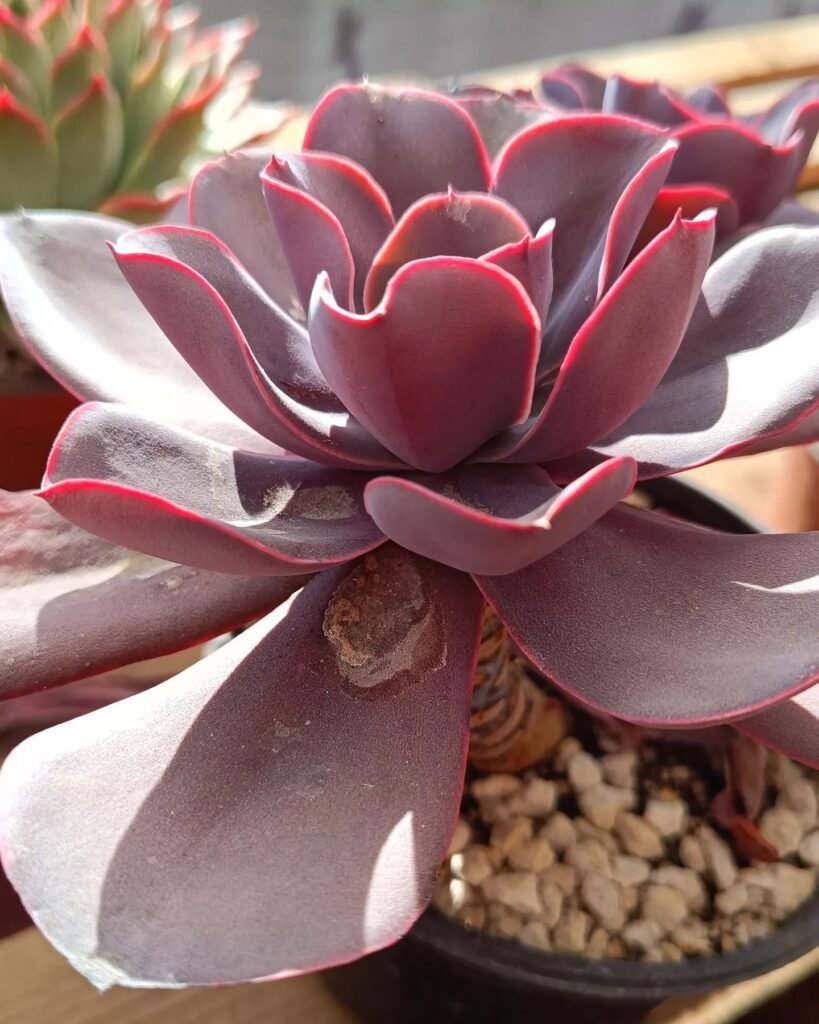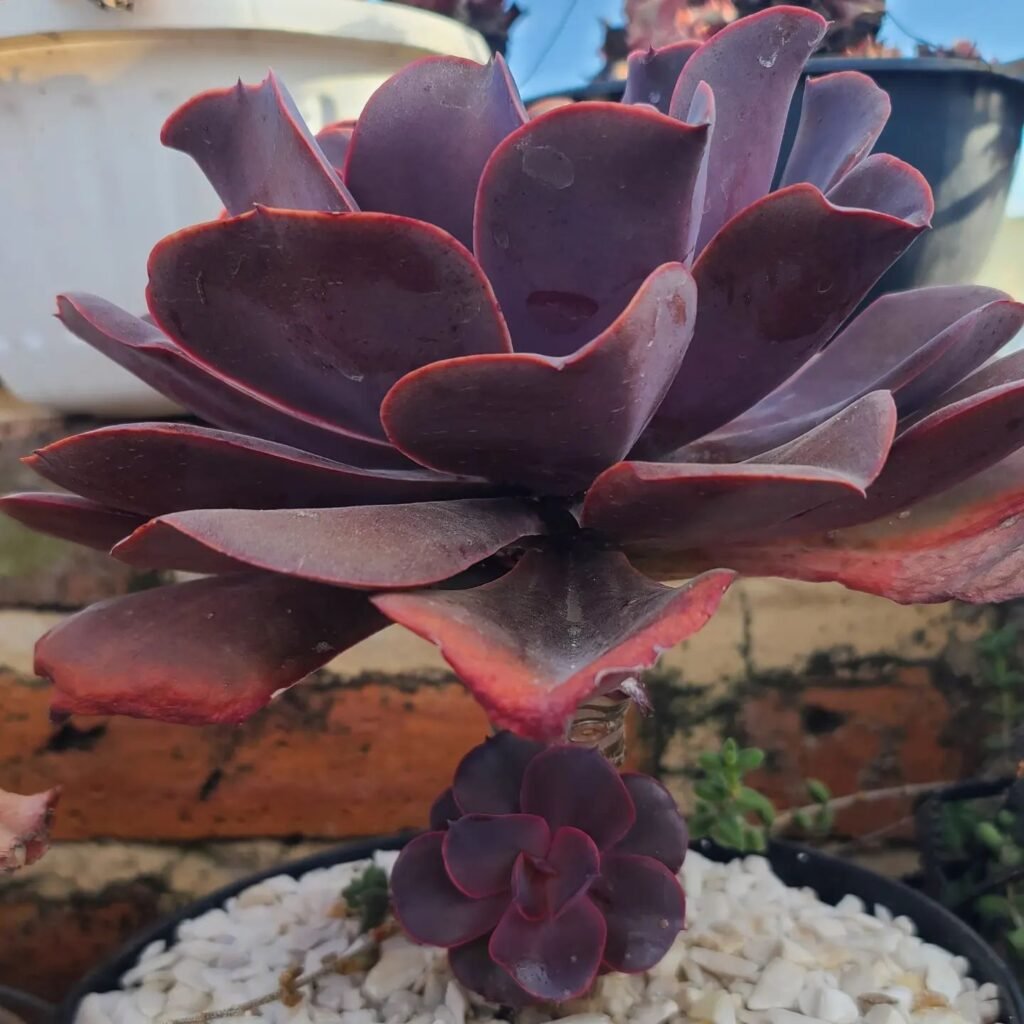Welcome to the enchanting world of the Echeveria Hortencia, a truly unique succulent that stands out in any garden. with its gorgeous purple leaves, is turning heads and winning hearts. Super easy for any gardener to care for, it’s making its mark in both cosy apartments and grand outdoor spaces. This hardy succulent thrives in the UK’s ever-changing weather, adding a burst of colour and a soothing vibe wherever it grows. No wonder it’s becoming a favourite among plant enthusiasts looking for a low-maintenance yet striking addition to their green spaces.
Appearance of Echeveria Hortencia


Echeveria Hortencia isn’t just another green plant. It’s a true show-stopper with its unique characteristics:
- Colourful Charm: This lovely succulent is renowned for its dark, almost purple leaves, giving it a dramatic and enchanting appearance. It’s like having a small piece of twilight right in your home.
- Rosette Formation: The plant forms beautiful, symmetrical rosettes, each leaf unfolding from the center in perfect harmony. This natural design is truly a sight to behold.
- Size and Shape: Typically, Echeveria Hortencia grows to a modest size, making it an ideal choice for small spaces. Its compact form is perfect for cozy gardens or indoor pots.
- Texture and Feel: The leaves are not just visually appealing but also have a pleasing texture. They are thick, fleshy, and have a smooth, almost waxy finish.
- Flowering Wonder: When in bloom, Echeveria Hortencia produces stunning flowers on tall stalks that rise above the rosette, adding an extra layer of beauty to this already gorgeous plant.
Echeveria Hortencia is more than just a plant; it’s a piece of living art. Whether you’re an experienced gardener or just starting out, this succulent is sure to bring joy and beauty into your life.
The Right Light for Echeveria Hortencia


Getting the light just right for your Echeveria Hortencia is a bit like finding the perfect spot for a cozy reading nook. This charming succulent loves plenty of sunshine but appreciates a bit of shade too. Here’s what you need to know:
- Sunlight is Key: Echeveria Hortencia thrives in bright light. A spot where it can bask in the morning sun and then enjoy some afternoon shade is ideal.
- Indoor Placement: If you’re keeping it indoors, a window that gets a good dose of sunlight, especially in the morning, will make your Hortencia happy.
- Avoid Harsh Sun: In the peak of summer, protect it from intense midday sun which can be a bit too much for its delicate leaves.
- Light and Growth: Proper sunlight ensures your Hortencia keeps its compact shape and vibrant color. Too little light might make it stretch out, reaching for the sun.
Remember, a happy Echeveria Hortencia is one that enjoys just the right balance of sunlight and shade, much like how we enjoy sunny days with a bit of cool breeze.

Watering Tips for Echeveria Hortencia


Watering your Echeveria Hortencia correctly is crucial for its health and beauty. Here’s how to get it right:
- Let it Dry: Wait until the topsoil feels dry before watering again. Overwatering can lead to root rot.
- Deep Soak: When you do water, soak the soil thoroughly so that moisture reaches the roots.
- Avoid Wet Leaves: Try not to get water on the leaves to prevent rot and fungal diseases.
- Less is More in Winter: Reduce watering in the colder months as the plant goes dormant.

Fertilizing and Choosing the Right Soil for Echeveria Hortencia


When it comes to Echeveria Hortencia, getting the soil and fertilization just right is crucial for its health and beauty. Here’s a quick and easy guide to help you understand what your succulent needs:
| Aspect | Details |
|---|---|
| Soil Type | Well-draining cactus or succulent mix. |
| Ingredients | Potting soil, coarse sand, perlite. |
| Fertilizer | Diluted cactus fertilizer. |
| Frequency | Once a month in spring and summer. |
| Avoid | Over-fertilizing; dense, water-retentive soil. |
This table provides a straightforward overview to ensure your Echeveria Hortencia grows healthy and vibrant.

Pruning and Maintenance for Echeveria Hortencia
Pruning and maintaining your Echeveria Hortencia is quite straightforward. Here’s a simple guide:
- Pruning Needs: Echeveria Hortencia typically requires minimal pruning. Just remove any dead or fading leaves to keep it tidy.
- Gentle Touch: Use your fingers or a small pair of scissors for pruning. Be gentle to avoid damaging the plant.
- Regular Checks: Keep an eye out for any signs of pests or diseases. Healthy leaves should be firm and vibrant.
- Maintenance Tips: Wipe the leaves gently with a damp cloth if they get dusty. This helps the plant breathe and stay healthy.

Propagating Echeveria Hortencia
Echeveria Hortencia, with its striking appearance, is not only a delight to grow but also wonderfully easy to propagate. Here’s how you can multiply this beautiful succulent:
- Leaf Propagation Explained:
- Selecting a Leaf: Look for a full, healthy leaf. Gently twist it off from the main plant.
- Callousing: Lay the leaf on a dry surface for a few days until the end callouses over.
- Planting: Place the calloused end on well-draining soil. Avoid burying it.
- Care: Water it lightly. Too much water can rot the leaf.
- Patience Pays Off: In a few weeks, you should see tiny roots and eventually a new plant.
- Growing from Offsets:
- Identifying Offsets: These are small plants growing at the base of the parent plant.
- Separation: Once they’re a decent size, gently detach them from the mother plant.
- Repotting Offsets: Plant them in their own pots with suitable succulent soil.
- Independent Growth: Care for them as you would the main plant. They’ll grow into new Echeveria Hortencias.
Each method offers a unique way to expand your collection and share this beautiful succulent with others.

Repotting Tips for Echeveria Hortencia
Repotting your Echeveria Hortencia is important for its health and growth. Here’s a simplified guide:
- When to Repot: Typically, every two to three years, or when you see roots coming out of the drainage holes.
- Choosing a Pot: Select a pot slightly larger than the current one, ensuring it has good drainage.
- Soil Selection: Use a well-draining cactus or succulent mix.
- The Process: Carefully remove the plant, shake off old soil, and check roots for health. Trim any damaged roots.
- Repotting: Place the plant in the new pot and fill with soil. Water lightly to settle the soil.
 Echeveria Hortencia is admired for its stunning rosette shape and vibrant color, often ranging from green to pink. It’s known for its easy propagation, where even a single fallen leaf can potentially grow into a new plant, showcasing the wonder of nature’s resilience.
Echeveria Hortencia is admired for its stunning rosette shape and vibrant color, often ranging from green to pink. It’s known for its easy propagation, where even a single fallen leaf can potentially grow into a new plant, showcasing the wonder of nature’s resilience.
Echeveria Hortencia FAQs

Got questions about your Echeveria Hortencia? We’ve got you covered! Here’s a list of FAQs to help new gardeners understand how to best care for and grow this beautiful succulent.
A striking succulent known for its purple leaves.
Bright, indirect light is ideal.
When the topsoil is dry.
Well-draining cactus mix.
Sparingly, during the growing season.
By leaf cuttings or offsets.
Yes, near a sunny window.
Every 2-3 years or if rootbound.
Not frost-tolerant; protect from extreme cold.
Simply just remove dead or damaged leaves.
Blooms in warmer months under proper conditions.
Generally considered non-toxic.
Hope you find these FAQs helpful! If you have any more questions, feel free to leave them in the comments. Happy gardening!

